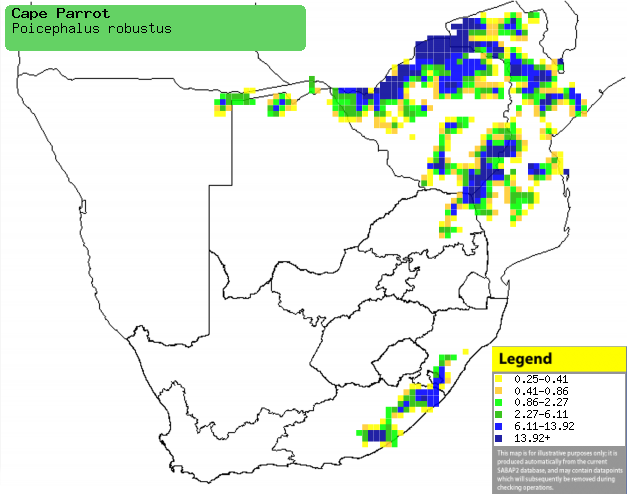|
Poicephalus robustus (Cape
parrot)
Woudpapegaai, Grootpapegaai [Afrikaans]; Isikhwenene
[Xhosa]; isiKhwenene [Zulu]; Hokwe (generic term for parrot) [Tsonga]; Kaapse
papegaai [Dutch]; Perroquet robuste [French]; Kappapagei [German];
Papagaio-de-bico-grosso [Portuguese]
Life
> Eukaryotes >
Opisthokonta
> Metazoa (animals) >
Bilateria >
Deuterostomia > Chordata >
Craniata > Vertebrata (vertebrates) > Gnathostomata (jawed
vertebrates) > Teleostomi (teleost fish) > Osteichthyes (bony fish) > Class:
Sarcopterygii (lobe-finned
fish) > Stegocephalia (terrestrial
vertebrates) > Tetrapoda
(four-legged vertebrates) > Reptiliomorpha > Amniota >
Reptilia (reptiles) >
Romeriida > Diapsida > Archosauromorpha > Archosauria >
Dinosauria
(dinosaurs) > Saurischia > Theropoda (bipedal predatory dinosaurs) >
Coelurosauria > Maniraptora > Aves
(birds) >
Order: Psittaciformes > Family: Psittacidae
The Cape parrot is endemic, endangered and highly localised,
being found in small patches of Afromontane forest in the Eastern Cape and
KwaZulu-Natal. It feeds exclusively on fruit, mainly foraging in the early
morning and late afternoon. It nests in pre-existing tree holes, especially in
Podocarpus (Yellowwood). The felling of yellowwood trees is the main
reason for its Endangered status, as it results in difficulty in location of
nesting sites, leading to a poor reproductive rate. The female lays 2-5 eggs,
which are incubated by by the female only, for 28-30 days. The chicks stay in
the nest for 55-79 days, after which they may remain with their parents for
about one year. For information, visit the
Cape Parrot Working Group.
To find out more about the Cape parrot, visit
the Cape Parrot Working Group.
Distribution and habitat
Endemic, rare and highly localised, occurring from Fort Beaufort, Eastern Cape to Karkloof, KwaZulu-Natal, with a 25-50
bird population in Wolkberg, Limpopo Province. It generally prefers Afromontane forest,
especially the canopies of yellowwood (Podocarpus) trees, such as Small-leaved yellowwood
(Afrocarpus falcatus).
|
 |
|
Distribution of Cape parrot in southern Africa,
based on statistical smoothing of the records from first SA Bird Atlas
Project (©
Animal Demography unit, University of
Cape Town; smoothing by Birgit Erni and Francesca Little). Colours range
from dark blue (most common) through to yellow (least common).
See here for the latest distribution
from the SABAP2. |
Call
Food
It feeds exclusively on fruit, mainly foraging
in the early morning and late afternoon. It occasionally forages in mixed-species
flocks, with Knysna turacos and
African green pigeons. The following food items have been
recorded in its diet:
- Fruit
- Afrocarpus falcatus (Small-leaved yellowwood)
- Podocarpus latifolius (Broad-leaved yellowwood)
- Celtis africana (White-stinkwood)
- Pteroxylon obliquum (Sneezewood)
- Scutia myrtina (Cat-thorn)
- Apodytes dimidiata (White-pear)
- Calodendrum capense (Cape-chestnut)
- Ficus craterostoma (Forest fig)
- Chionanthus peglerae (Giant pock-ironwood)
- Greyia sutherlandii (Glossy bottlebrush)
- Commiphora woodii (Forest corkwood)
- Eugenia zuluensis (Paper-back myrtle)
- Harpephyllum caffrum (Wild-plum)
- Erythrina lysistemon (Sacred coral-tree)
- Erythrina caffra (Coastal coral-tree)
- Mimusops caffra (Coast red-milkwood)
- Ocotea bullata (Stinkwood)
- Olea capensis (Small ironwood)
- Pittosporum viridiflorum (Cheesewood)
- Podocarpus henkelii (Drooping-leaved yellowwood)
- Pseudolachnostylis maprounifelia (Kudu-berry)
- Protea caffra (Common protea)
- Prunus africana (African almond)
- Rapanea melanophloeos (Cape-beech)
- Alien trees
- Acacia mearnsii (Black wattle)
- Melia azedarach (Persian lilac)
Breeding
- It nests in pre-existing tree holes, especially in yellowwoods (Podocarpus). The felling of yellowwood trees is the main
reason for its Endangered status, as it results in difficulty in location of
nesting sites, leading to a poor reproductive rate.
- Egg-laying season is year-round, peaking from August-February.
- It lays 2-5 eggs, which are incubated by by the female only, for 28-30
days.
- The chicks stay in the nest for 55-79 days, and are fed mainly on Broad-leaved yellowwood
kernels (Afrocarpus falcatus) and seeds of Black wattle (Acacia mearnsii).
They probably remain dependent on their parents up to a year after fledging,
although this has not been confirmed.
Threats
Range-restricted and Endangered, caused mainly by habitat
loss, low reproductive success, the cage bird trade and persecution. For more
information on its conservation, visit the
Cape Parrot Working Group.
References
-
Hockey PAR, Dean WRJ and Ryan PG (eds) 2005. Roberts -
Birds of southern Africa, VIIth ed. The Trustees of the John Voelcker
Bird Book Fund, Cape Town.
|
